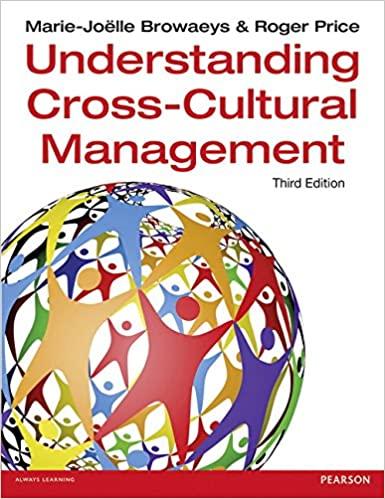d) Use 5 dimensions of Hofstede's model of national cultures to assess Ford Motors presence in CHINA AND UAE. Evaluate the national culture of both countries and discuss how they differ from Ford Motor's home county culture, according to Hofstede.
e) Explain how these differences can have an impact on the HRM practices of the company in CHINA and the UAE, support your answer with clear arguments.
Ford Motor Company has been in business for over 100 years and when it comes to a global mind-set, Ford is ahead of most of its competitors. For a number of historical reasons, over the years Ford evolved into a collection of country and regional fiefdoms. Early in its history, Ford was like many large firms, which often sent people off to other major countries to run a company just like the one back home. The first Henry Ford, the founder of the Ford Motor Company, was in many ways an internationalist, because within a very few years of establishing the company in the US he was opening assembly and manufacturing plants all over the world - the first of which was a Model T assembly plant in Trafford Park, England, in 1911--that were essentially smaller versions of the original company in Detroit. But by the mid-1920s a sense of local pride had developed in countries around the world. Countries began to develop their own automotive companies. Suddenly, there were automotive companies in the UK, in France, Germany, Australia, and they were all making their own vehicles. Nations wanted to assert their independence and saw the automotive industry as a means of investing in their own economies. The Europeans exported, the Americans exported, and that's how the competitive game was being played. (This was the beginnings of the "multidomestic" structure for large multinational corporations, as explained in this chapter.) In the 1960s, though, regionalism began to develop, with the emergence of the European Common Market, NAFTA, ASEAN, and other regional trading groups. Countries kept their own political systems and social values but formed economic trading blocs. So... big companies established regional headquarters within the various major trading blocs. Ford Europe was established in this period. This was when most of the regional and functional fiefdoms (with each region becoming very independent) became firmly entrenched at Ford. (This is what is referred to in the text as the "regional" corporate structure, an extension of the "multidomestic" structure. The fiefdoms were excellent at what they did: they squeezed every last ounce of efficiency out of the regional model. For example, back in the period of nationalism, Ford had multiple accounting activities around the world there were fifteen in Europe alone. The regional model got it down to four: one in Europe, one in the US, one in Asia-Pacific, and one in South America. But even with that efficiency, Ford felt that the model didn't work any more. Today Ford is moving to a fourth stage of economic evolution with the globalization of all aspects of its international operations: capital, communications, economic policy, trade policy, human resources, marketing, advertising, brands, etc. The auto industry around the world has become globalized. Germany and Japan produce cars in the US, Korea produces cars in Eastern Europe, and Malaysia, China, and Mexico export cars and parts throughout the world. Ford now manufactures and distributes automobiles in 200 markets on six continents, with 330,000 employees in more than 100 plants worldwide. In addition, the automotive industry has become an electronics-driven industry. It is increasingly a business that requires huge investments in technology and intellectual capital, not only for constant innovations in development and manufacturing, but in automobiles, themselves So the leadership of Ford feels there is no longer a choice about globalization. For a company of Ford's background and size, remaining a national or regional company is no longer a viable alternative. Auto companies around the world have global ambitions, and many of them are world-class players, such as Toyota, Honda, Volkswagen, Daimler-Chrysler, Renault and, quite soon, Geely Motors and others from China and Tata Motors from India. In this environment, Ford sees an incredible challenge: more markets open for business, more competitors fighting for dominance, more need for very smart people and fresh ideas. Ford feels that it can't build such a company if it holds on to a mind-set that doesn't respond swiftly to the global) consumers' needs or pay attention to the (global) capital markets. So, under the leadership originally of Jacques Nasser. then of William Ford III, and now of Alan Mulally, Ford has begun to reinvent itself as a truly global organization with a single strategic focus on consumers and shareholder value. Ford realizes that, in this process, it must not try to eliminate the role of national cultures or eliminate the idea that it makes sense to have people with expertise in one function or another, but it wants to develop a Ford-wide corporate DNA that drives how it does things everywhere. That DNA has a couple of key components, including a global mind-set, an intuitive knowledge of Ford's customers around the world, and a relentless focus on growth, where every employee contributes to the company and to business results. Many large, experienced, multinational firms are now trying to develop a global structure and frame of mind similar to what Ford is doing, as they all see it as necessary for successful operation in today's globalized economy. And it is HR which must take the responsibility to develop this corporate DNA. Sources Lapid, K. (2006), Outsourcing and offshoring under the General Agreement on Trade in Services, Journal of World Trade, 40 (2): 341-364: Neff, J. (2006), Ford announces corporate realignment, Autoblog, December 14; Wetlaufer, S. (1999). Driving change: An interview with Ford Motor Company's Jacques Nasser, Harvard Business Review, March-April: 77-80; and Whitney, K. (2006). Ford: Driving learning and leveloping the "Way Forward," Chief Leaming Officer, 5 (5): 44-47








